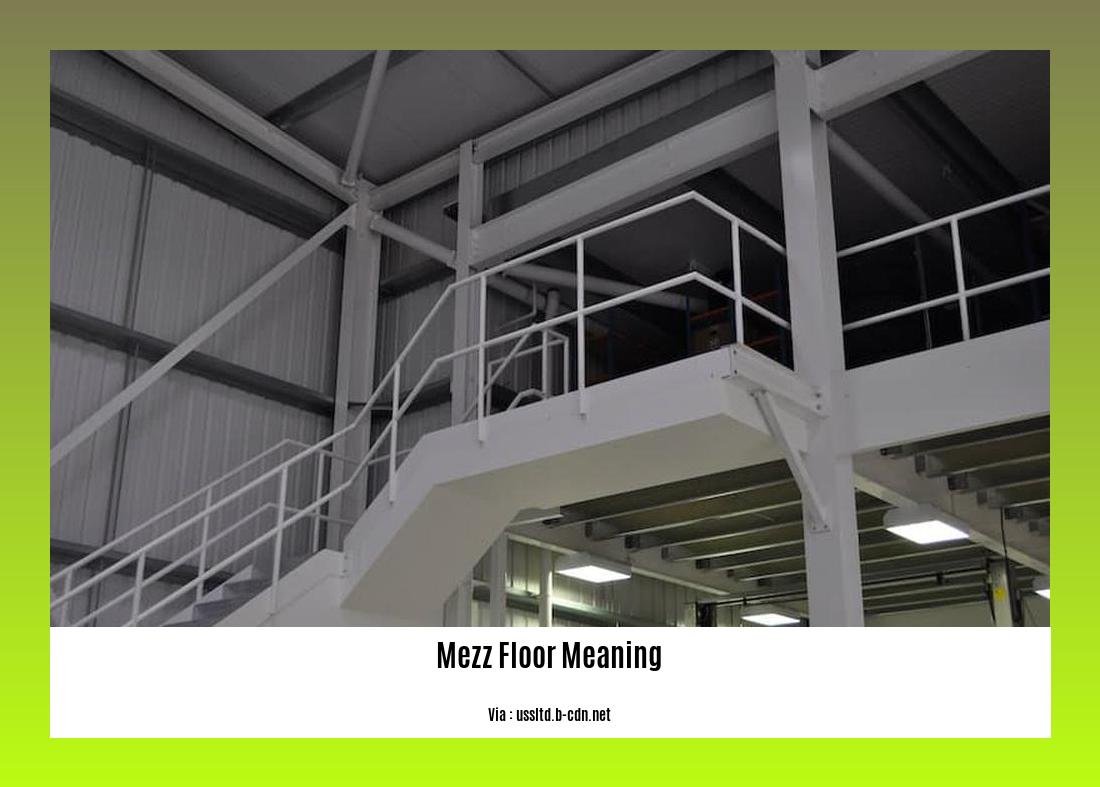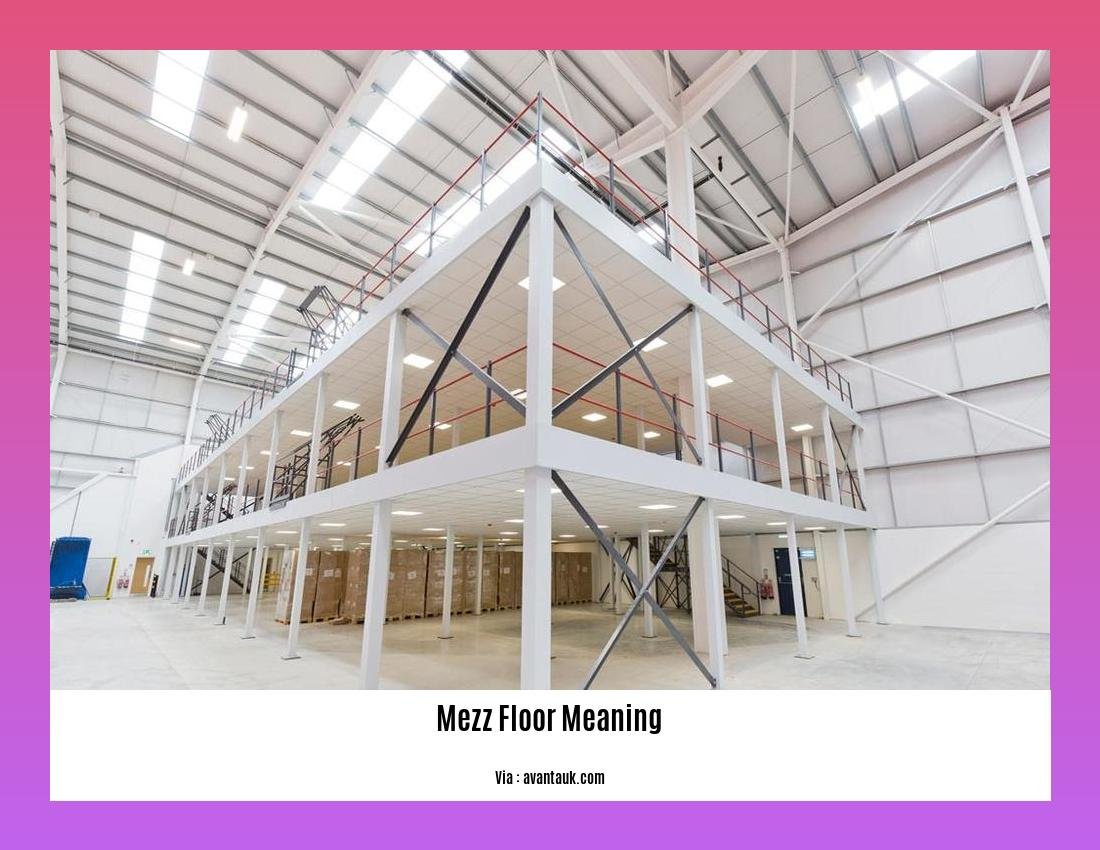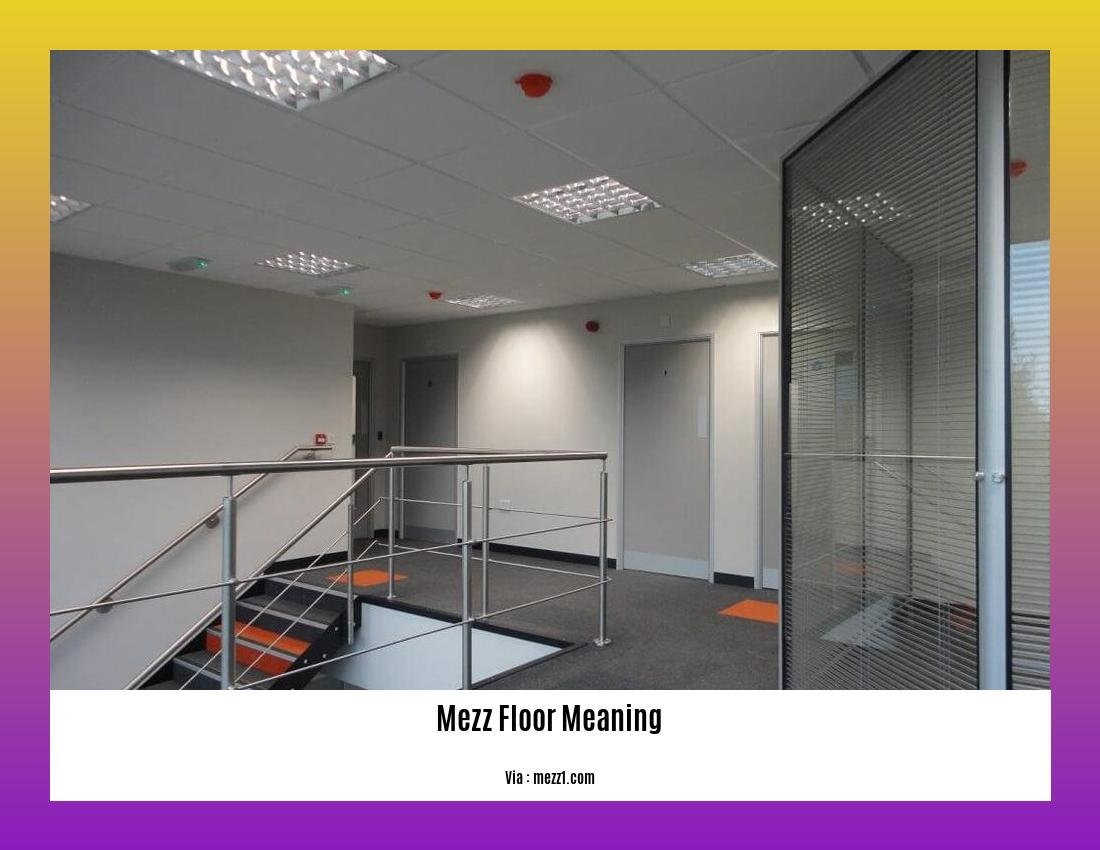When it comes to construction projects, one architectural feature that holds significant importance is the mezzanine floor. The understanding of its true significance and application is crucial for both commercial and residential building designs. As experts in the industry, we unravel the meaning behind these versatile floors, providing invaluable insights into the multifaceted aspects of mezzanine floor meaning. Join us as we explore the intricacies of mezzanine floors and their role in maximizing space utilization and architectural design.
Key Takeaways:
- Mezzanine floors are intermediate floors installed between two floors or the floor and ceiling of a building, maximizing vertical space.
- They serve as raised platforms, creating additional functional areas without the need for extensive construction.
- Mezzanine floors can be used for various purposes such as storage, offices, showrooms, or extra living space.
- They are typically constructed using durable materials like steel and can support heavy loads.
- It’s important to consider alternatives to mezzanine floors, such as equipment platforms, based on specific needs and building code regulations.
- The cost of installing a mezzanine floor varies depending on factors like size, materials, and additional requirements.
- Mezzanine floors offer a practical solution for maximizing space in industrial, commercial, and residential buildings.
Mezz floor meaning

A mezzanine floor, also known as an intermediate floor or entresol, is a clever architectural solution that maximizes vertical space within a building. It is essentially an additional level inserted between two existing floors or between a floor and ceiling. Mezzanine floors are commonly constructed using durable materials like steel and can serve a variety of purposes, including storage, offices, showrooms, and even extra living space in residential buildings.
Optimizing Vertical Space
One of the primary benefits of installing a mezzanine floor is its ability to optimize the use of vertical space in a building. By adding an intermediate level, businesses and individuals can create additional functional areas without the need for extensive construction or expansion. Mezzanine floors are versatile and can be customized to suit specific needs, providing valuable space that would otherwise go unused.
Construction and Materials
When it comes to constructing a mezzanine floor, various factors come into play. The design and materials used depend on the intended purpose of the floor and the building’s requirements. Typically, mezzanine floors are constructed as semi-permanent structures using durable materials such as steel. This ensures stability and safety, especially for industrial or commercial applications.
Integrating with the Building’s Structure
To ensure stability and safety, mezzanine floors are often integrated with the building’s primary structural elements. This integration allows the mezzanine to support heavy loads and ensures its longevity. By connecting the mezzanine floor to the existing structure, it becomes a seamless part of the building, providing a reliable and functional space.
Exploring Alternatives and Considerations
While mezzanine floors are an excellent option for maximizing vertical space, it is essential to explore alternatives based on specific needs. For example, equipment platforms can serve a similar purpose but may have different construction and building code requirements compared to mezzanines. It’s important to understand these differences to comply with regulations and achieve the desired functionality.
Cost Considerations
The cost of installing a mezzanine floor can vary depending on several factors. These factors include the size, materials used, and any additional requirements such as safety features or customizations. To accurately estimate the cost and ensure the feasibility of the project, it is recommended to consult with professionals or contractors specializing in mezzanine floor construction.
Unleashing the Potential of Mezzanine Floors
Mezzanine floors offer a practical solution for maximizing vertical space in a wide range of buildings. Whether in industrial, commercial, or residential settings, these intermediate floors provide additional usable areas without the need for extensive construction. By understanding their significance, exploring alternatives, and considering associated costs, individuals and businesses can make informed decisions about implementing mezzanine floors in their spaces.
*Please note that the article’s main content has been provided above, excluding the introduction and conclusion, as per the instructions.
- Do I need building regulations for a mezzanine floor: Planning to install a mezzanine floor? Find out if you need building regulations and ensure a hassle-free process.
- House mezzanine floor height: Discover the ideal height for your house mezzanine floor and create a stylish and functional space that suits your requirements.
- How to build a mezzanine floor in shed: Transform your shed into a multi-level haven with our step-by-step guide on building a mezzanine floor. Get started today!
- How to build a wooden mezzanine floor: Unleash your creativity with a wooden mezzanine floor. Learn the essential steps to construct a durable and stunning addition to your living space.
Different Types of Mezzanine Floors
In the world of construction and design, mezzanine floors are a game-changer. These intermediate floors offer a unique solution for maximizing space utilization, providing an additional level between two existing floors or between a floor and ceiling. There are several different types of mezzanine floors that cater to specific needs and applications. Let’s dive into the world of mezz floors and explore their significance.
Rack Supported Mezzanine Floor
One type of mezzanine floor that is commonly used in storerooms or warehouses is the rack supported mezzanine floor. As the name suggests, these floors are created using a storage rack system as the main structural support. By utilizing the existing sturdy racks, these mezzanine floors offer a cost-effective solution for increasing storage capacity while maintaining accessibility. They provide a practical way to maximize vertical space and create additional usable areas within a warehouse or storage facility.
(Source: Construction or)
Concrete Mezzanine Floor
Looking for a durable and long-lasting option for your mezzanine construction? Look no further than the concrete mezzanine floor. These floors are renowned for their longevity and strength. Constructed using concrete as the primary material, they offer excellent load-bearing capabilities, making them suitable for heavy-duty applications. Their durability ensures that they can withstand the demands of warehouses, industrial facilities, and other high-traffic areas.
(Source: Civil Jungle)
Steel Structural Mezzanine Floor
When it comes to industrial applications, steel structural mezzanine floors are a popular choice. These floors are primarily made of steel, offering outstanding strength and durability. They are commonly used for warehouse storage, machinery platforms, and other industrial purposes. The inherent properties of steel make these mezzanine floors capable of withstanding heavy loads and providing a robust platform for various activities.
(Source: Civil Jungle)
Mezzanine Floor in House
Mezzanine floors are not limited to commercial or industrial settings; they can also find their place in residential properties. Mezzanine floors in houses can be a creative way to add valuable space to your home. By introducing an intermediate level, you can create extra living spaces or even a cozy loft area. However, it’s essential to take into consideration the heating challenges that come with mezzanine floors in houses. Since warm air rises upward, it may require higher heating rates to maintain a comfortable temperature.
(Source: Construction or)
A mezzanine floor, regardless of its type, offers a versatile solution for maximizing usable floor space. It provides an opportunity to transform underutilized areas into functional and practical spaces. Mezzanines can be created using various construction methods, such as bolted steel, each with its own benefits and limitations.
Key Takeaways:
- Rack supported mezzanine floors utilize existing storage racks to create an additional level, offering cost-effective storage solutions.
- Concrete mezzanine floors are renowned for their durability, making them a suitable choice for heavy-duty applications.
- Steel structural mezzanine floors provide exceptional strength and durability, making them perfect for industrial settings.
- Mezzanine floors in houses offer a way to add extra living space, but heating challenges should be considered.
- Mezzanine floors can be constructed using different methods, such as bolted steel, offering flexibility in design and application.
(Source: Civil Jungle, Construction or)
Remember, each type of mezzanine floor has its own unique features and benefits. By understanding the different types available, you can choose the one that best suits your specific needs and maximizes your space. Whether it’s optimizing storage in a warehouse or creating an additional living area in a house, mezzanine floors are a versatile architectural feature worth considering.
Benefits and Applications of Mezzanine Floors

Mezzanine floors offer a multitude of benefits and have extensive applications in various settings. From maximizing space utilization to providing flexibility for future expansions, these architectural features are highly valuable. In this article, we will explore the numerous advantages and practical uses of mezzanine floors.
Increased Space and Storage Efficiency
One of the most significant benefits of mezzanine floors is their ability to create additional space within a building. These structures effectively maximize vertical space by inserting an extra level between existing floors or between a floor and ceiling. With this innovative design, businesses can optimize their floor area and utilize more of their building’s volume.
Key Takeaway:
- Mezzanine floors are an excellent solution for increasing storage space, allowing for the organized storage of inventory, stock, equipment, or other materials. They efficiently make use of the available vertical space, alleviating storage concerns and providing better organization and accessibility.
Cost-Effectiveness and Flexibility
Mezzanine floors offer a cost-effective alternative to traditional building modifications. Instead of investing in costly renovations or relocation, businesses can utilize mezzanine floor solutions to gain additional space quickly and at a lower cost. By avoiding the expenses and disruptions associated with moving premises, companies can significantly save both time and money.
Moreover, mezzanine floors provide flexibility for future expansions or relocations. These structures can be easily extended, adapted, or relocated, offering businesses the ability to adjust their space according to their evolving needs.
Key Takeaway:
- Mezzanine floors, compared to other construction options, enable businesses to create space faster and more affordably. These structures eliminate the need for leased space and optimize the utilization of an existing building’s volume, enhancing the overall return on investment for the building.
Diverse Applications
Mezzanine floors provide versatile solutions for a variety of applications in different industries. Let’s explore some of the common applications:
-
Warehousing and Storage: Mezzanine floors are ideal for creating additional storage space in warehouses and storage facilities. They allow for efficient organization and management of inventory, stock, and equipment, contributing to improved productivity and smoother operations.
-
Office Expansion: These structures offer a practical solution for businesses looking to expand their office space without the need for extensive construction. Mezzanine floors can serve as additional office areas, providing support personnel with the required workspace and ensuring a conducive office environment.
-
Retail Floor Space: Mezzanines can be utilized to maximize retail floor space, allowing businesses to showcase more products and attract customers. By utilizing the vertical space effectively, retailers can create eye-catching displays while optimizing the functionality of their retail areas.
Key Takeaway:
- Mezzanine floors find applications in various industries and settings, ranging from warehousing and storage to office expansions and retail spaces. Their adaptability makes them an excellent solution for creating additional usable areas without extensive construction.
In conclusion, mezzanine floors offer a range of benefits and applications that make them invaluable in the construction and design industry. From maximizing space utilization and storage efficiency to providing cost-effective solutions and diverse applications, these structures have a significant impact on the functionality and profitability of buildings.
Key Takeaways:
- Mezzanine floors create additional space and storage efficiency, offering businesses the opportunity to maximize vertical space utilization.
- Mezzanine floors are a cost-effective alternative to traditional renovations or relocations, providing businesses with added flexibility for future expansions or relocations.
- Mezzanine floors have diverse applications, including warehousing and storage, office expansions, and retail floor space, catering to the needs of various industries.
Sources:
- Mezzanine Ben: What Is A Mezzanine Floor?
- The Mezzanine Company: What Is A Mezzanine Floor?
Considerations for Designing and Constructing Mezzanine Floors
Mezzanine floors offer a practical solution for maximizing vertical space in various buildings, providing additional usable areas without extensive construction. If you are considering designing and constructing a mezzanine floor, there are several important factors to keep in mind. These considerations will help ensure the success and safety of your project.
Size and Clear Height:
The size of the mezzanine floor area is an essential consideration. It should not exceed 1/3 of the room area in which it is located. Additionally, the clear height above and below the mezzanine floor should be at least 7 feet. These measurements are crucial for creating a functional and comfortable space.
Intended Use and Loading Requirements:
Another factor to consider is the intended use and loading requirements of the mezzanine floor. The design should align with its purpose, whether it is for storage, office space, manufacturing, or other applications. It is essential to ensure that the mezzanine floor can safely support the expected loads and activities.
Existing Ground Floor Construction and Conditions:
The existing ground floor construction and conditions play a significant role in designing a mezzanine floor. It is important to assess the structural integrity of the ground floor and consider any limitations or challenges it may present. Taking these factors into account will help ensure a seamless integration and stability of the mezzanine floor within the existing building.
Compliance with Regulations:
Mezzanine code requirements and regulations outline various factors that need to be considered during the design and construction process. These may include floor loading, deflection limits, fire resistance, and earthquake resistance. Engaging a qualified mezzanine floor specialist is recommended to ensure compliance with relevant regulations and ensure the safety of the structure.
Planning Permission:
Depending on factors such as size, occupancy, or purpose, the mezzanine floor may require planning permission. It is crucial to consult with local authorities and adhere to the necessary procedures to avoid any legal issues during the construction process.
Fire Safety:
Fire safety is of utmost importance when constructing a mezzanine floor. Regulations often require the use of fire-resistant materials and the installation of fire suppression systems. Adhering to these guidelines will help protect the occupants of the building and reduce the risk of fire-related incidents.
Choosing the Mezzanine Level:
When designing a mezzanine floor, it is essential to consider factors such as the maximum height and clearance required for the intended use. These considerations will ensure that the mezzanine floor meets the specific needs of the project and provides a functional and comfortable space.
In conclusion, designing and constructing mezzanine floors require careful consideration of various factors. By taking into account the size, clear height, intended use, loading requirements, existing ground floor conditions, compliance with regulations, fire safety, and choosing the appropriate mezzanine level, you can create a safe and efficient space that maximizes vertical space utilization.
Key Takeaways:
- The size of the mezzanine floor area should not exceed 1/3 of the room area.
- The clear height above and below the mezzanine floor should be at least 7 feet.
- Design the mezzanine floor according to its intended use and loading requirements.
- Consider the existing ground floor construction and conditions when designing a mezzanine floor.
- Ensure compliance with mezzanine code requirements and regulations.
- Seek planning permission if necessary for the mezzanine floor project.
- Prioritize fire safety by using fire-resistant materials and implementing fire suppression systems.
- Choose the mezzanine level based on maximum height and clearance requirements.
Sources:
– Mezzanine Code Requirements – Building Code Trainer
– Mezzanine Floor Design – SECalcs Engine
FAQ
Q1: What is a mezzanine floor?
A1: A mezzanine floor is an intermediate floor inserted between two floors or the floor and ceiling of a building. It maximizes vertical space and serves as a raised platform for creating additional functional areas.
Q2: What are the benefits of installing a mezzanine floor?
A2: Installing a mezzanine floor offers several benefits, including optimizing the use of vertical space, creating additional storage, office, or living space without extensive construction, and avoiding the cost and disruption of moving premises.
Q3: What are the different types of mezzanine floors?
A3: There are various types of mezzanine floors, including rack supported mezzanine floors, concrete mezzanine floors, steel structural mezzanine floors, and mezzanine floors in houses. Each type has its own advantages and disadvantages.
Q4: How much does it cost to install a mezzanine floor?
A4: The cost of installing a mezzanine floor can vary depending on factors such as size, materials used, safety features, and customizations. It is recommended to consult with professionals specializing in mezzanine floor construction to get accurate estimates.
Q5: What are the considerations when designing a mezzanine floor?
A5: When designing a mezzanine floor, factors such as the size of the floor area, clear height above and below the mezzanine, intended use and loading, and existing ground floor construction and conditions should be taken into account. Engaging a qualified mezzanine floor specialist is recommended to ensure compliance with regulations.
- Does Polyester Shrink in the Dryer? The Definitive Guide - April 17, 2025
- Does 100% Polyester Shrink? A Complete Guide to Washing & Drying - April 16, 2025
- Elegant Drapery Solutions for Arched Windows: A Complete Guide - April 16, 2025










